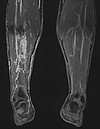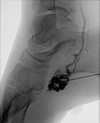You are here
Content
The Interdisciplinary Centre for Vascular Anomalies at the University Hospital Mannheim was established in 2014 by Professor Maliha Sadick, an Interventional Radiologist at the Department of Clinical Radiology and Nuclear Medicine. The members of its multidisciplinary team of clinicians, scientists and paramedical professions are specialized and involved in diagnosis, treatment and ongoing dedicated care of patients – from new-born to adult – with congenital vascular anomalies. It is one of the very few centres for vascular anomalies in Germany under radiological management that can provide diagnostics, minimal-invasive treatment options and holistic care to people with this rare disease.
Multidisciplinary team approach and scientific work
To address all aspects of the patient’s vascular anomaly as far as diagnosis, treatment, and rehabilitation are concerned, the Interdisciplinary Centre for Vascular Anomalies cooperates with other clinical disciplines. Management of vascular anomalies needs a broad spectrum of health care professionals because the skills of many different specialties are required to address each aspect of the problem, depending on the severity of the lesion.
The following disciplines are members of our Interdisciplinary Centre for Vascular Anomalies:
- Dermatology
- Paediatrics
- Paediatric surgery
- Paediatric orthopaedics
- Plastic and Reconstructive surgery
- Vascular surgery
- Otolaryngology
- Pathology
- Angiology
- Haematology
- Genetics
The Interdisciplinary Centre for Vascular Anomalies has regular board meetings. Patient cases are discussed and reviewed in the interdisciplinary clinical conference and then scheduled for therapy.
We are participating in research on vascular anomalies and publishing latest findings in medical journals.
The Interdisciplinary Centre for Vascular Anomalies is a member of the German Society for the Study of Vascular Anomalies (DiGGefa) and the International Society for the Study of Vascular Anomalies (ISSVA).
What are Vascular Anomalies?
Vascular anomalies are vessel abnormalities that can affect the capillaries, veins, arteries and lymphatics, either individually or combined and can occur in any region of the body, affecting vessels and other anatomical structures of the body.
Vascular anomalies are classified in:
- tumours, ranging from frequent tumours such as hemangiomas, to rare ones such as kaposiform hemangioendothelioma
- malformations, including venous malformations as well as combined malformations and malformation syndromes such as Klippel-Trénaunay syndrome, which involves malformations of the capillaries, veins and lymphatic vessels
Vascular anomalies are considered the most severe and complex amongst vascular diseases. There are no exact data available on the number of patients with vascular anomalies – but according to estimates about 450,000 people diagnosed with vascular anomalies live in Germany alone.
Treatment Options
- conservative management (e.g. pain therapy, compression therapy, physiotherapy)
- minimal-invasive radiological treatment (e.g. sclerotherapy, embolization)
- surgery
Planning Your Visit
Patients with an appointment at the Interdisciplinary Centre for Vascular Anomalies are kindly asked to provide the following items or send them prior to the appointment:
- Any relevant medical records regarding the vascular anomaly
- Imaging studies (e.g. MRI, CT, ultrasound, venograms, angiography, others)
- Laboratory findings on coagulation
Context Column
About the International Patient Office
The International Patient Office (IPO) welcomes patients from all over the world and assists with requests for medical treatment. Click here to read more about the IPO.


